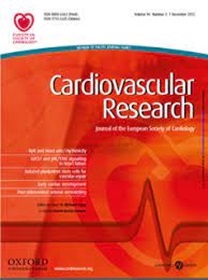Single-cell epigenomic and transcriptomic analysis unveils the pivotal role of GATA5/ISL1+ fibroblasts in cardiac repair post-myocardial infarction
IF 13.3
1区 医学
Q1 CARDIAC & CARDIOVASCULAR SYSTEMS
引用次数: 0
Abstract
Aims A comprehensive understanding of the genome-wide regulatory landscape of the cardiac tissues post-myocardial infarction (MI) is still lacking. We therefore integrated single-cell RNA sequencing (scRNA-seq) and single-cell for transposase-accessible chromatin sequencing (scATAC-seq) to elucidate the epigenetic landscape of the heart post-MI. Methods and results We established MI mice through ligation of the left anterior descending coronary artery, and obtained cardiac tissues from mice at 1,3,7 and 14-day post-MI. Integrative analyses of the scRNA-seq and scATAC-seq data revealed the presence of two novel fibroblast subpopulations in the MI cardiac tissues, termed GATA-binding protein 5/ISL LIM Homeobox 1 (GATA5/ISL1) + fibroblasts and GLI family zinc finger 3 (Gli3) high fibroblasts. The GATA5/ISL1+ fibroblasts were characterized by fibroblast and cardiomyocyte signatures and were found to play a crucial role in cardiac repair post-MI. Moreover, adenoviral-mediated overexpression of GATA5 and ISL1 ameliorated cardiac function and attenuated myocardial fibrosis in the MI mice. RNA sequencing confirmed that GATA5 and ISL1 co-regulate Wnt signaling pathway to promote the transformation of fibroblasts into functional cardiomyocytes. Furthermore, analysis of the human cardiac tissues of MI patients also revealed the presence of GATA5/ISL1+ fibroblasts in the scar tissues, suggesting their crucial role in cardiac tissue repair post-MI. In addition, proteomic analyses revealed enhanced cardiac repair and development signaling in the GATA5/ISL1-overexpressing human cardiac fibroblasts. Conclusions The study provides novel perspectives on the mechanisms of myocardial injury and repair at the single-cell level and indicates the potential role of GATA5 and ISL1 as therapeutic targets for MI treatment.单细胞表观基因组学和转录组学分析揭示了GATA5/ISL1+成纤维细胞在心肌梗死后心脏修复中的关键作用
目的对心肌梗死(MI)后心脏组织的全基因组调控景观的全面了解仍然缺乏。因此,我们整合了单细胞RNA测序(scRNA-seq)和单细胞转座酶可及染色质测序(scATAC-seq)来阐明心肌梗死后心脏的表观遗传景观。方法与结果通过结扎左冠状动脉前降支建立心肌梗死小鼠,分别于心肌梗死后1、3、7、14天获得心肌组织。scRNA-seq和scATAC-seq数据的综合分析显示,心肌组织中存在两种新的成纤维细胞亚群,称为gata结合蛋白5/ISL LIM Homeobox 1 (GATA5/ISL1) +成纤维细胞和GLI家族锌指3 (Gli3)高成纤维细胞。GATA5/ISL1+成纤维细胞具有成纤维细胞和心肌细胞特征,并在心肌梗死后的心脏修复中发挥关键作用。此外,腺病毒介导的GATA5和ISL1的过表达改善了心肌梗死小鼠的心功能并减轻了心肌纤维化。RNA测序证实GATA5和ISL1共同调控Wnt信号通路,促进成纤维细胞向功能心肌细胞转化。此外,对心肌梗死患者的人心脏组织的分析也发现,疤痕组织中存在GATA5/ISL1+成纤维细胞,表明它们在心肌梗死后心脏组织修复中起着至关重要的作用。此外,蛋白质组学分析显示,在过表达GATA5/ isl1的人心脏成纤维细胞中,心脏修复和发育信号通路增强。结论本研究为单细胞水平心肌损伤和修复机制的研究提供了新的视角,并提示GATA5和ISL1作为心肌梗死治疗靶点的潜在作用。
本文章由计算机程序翻译,如有差异,请以英文原文为准。
求助全文
约1分钟内获得全文
求助全文
来源期刊

Cardiovascular Research
医学-心血管系统
CiteScore
21.50
自引率
3.70%
发文量
547
审稿时长
1 months
期刊介绍:
Cardiovascular Research
Journal Overview:
International journal of the European Society of Cardiology
Focuses on basic and translational research in cardiology and cardiovascular biology
Aims to enhance insight into cardiovascular disease mechanisms and innovation prospects
Submission Criteria:
Welcomes papers covering molecular, sub-cellular, cellular, organ, and organism levels
Accepts clinical proof-of-concept and translational studies
Manuscripts expected to provide significant contribution to cardiovascular biology and diseases
 求助内容:
求助内容: 应助结果提醒方式:
应助结果提醒方式:


